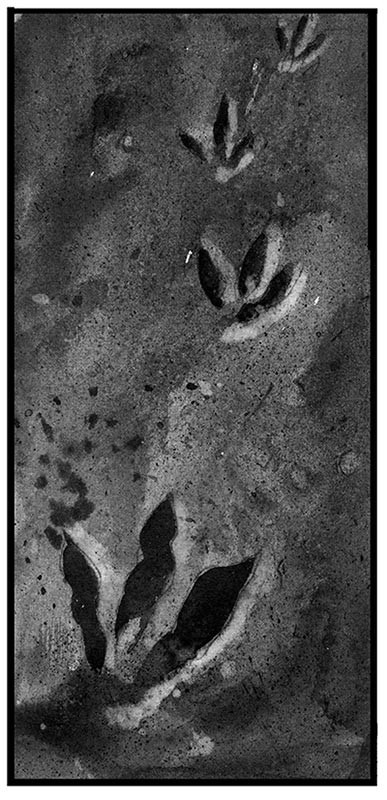
Imagine taking a walk through a part of New England you’ve never seen—how it was 190 million years ago.
This New England is hot, and the infrequently replenished lakes are surrounded by drying mudflats. As you squelch across the mud, you cross other footprints – three-toed tracks. A squall of rain passes through, coming and going so quickly that the pattern of drops is left in the mud. What plants can be seen are familiar: ferns, horsetails, and conifers, but none of the species are recognizable, and there aren’t any hardwoods.
A couple of partially-feathered creatures about the size of a turkey pop out of a stand of ferns. By the water you spot a flock of bigger animals, lean and predatory, catching fish. And then an even bigger pair of animals, each longer than a car, with ostentatious crests on their heads, stalk out of the heat haze. The fish-catchers dart aside, but the new pair have just come to drink.
We can only speculate what a walk through Jurassic New England would be like, but the fossil record leaves many hints. According to Matthew Inabinett, one of the Beneski Museum of Natural History’s senior docents and a student of vertebrate paleontology, dinosaur footprints found in the sedimentary rock of the Connecticut Valley reveal much about these animals and their environment.
At the time, the land that we know as New England was further south, close to where Cuba is now. A system of rift basins that cradled lakes ran right through our region, from North Carolina to Nova Scotia. As reliable sources of water, with plants for the herbivores and fish for the carnivores, the lakes would have been havens of life.
While most of the fossil footprints found in New England so far are in the lower Connecticut Valley, they provide a window into a world that extended throughout the region. According to Inabinett, the tracks generally fall into four groupings. He explained that these names are for the tracks, not the dinosaurs that made them, since, “it’s very difficult, if not impossible, to match a footprint to a particular dinosaur species.” And it could be that each track type includes tracks from multiple species with very similar feet.
Anomoepus tracks are only a couple of inches long. They are three-toed (most dinosaurs were four-toed, but like the dewclaw on a dog, this toe is rarely seen in their tracks) and were probably made by three- to five-foot bipedal beaked herbivores in the ornithischian group. This is the group that includes Stegosaurus and the hadrosaurids, or duck-billed dinosaurs, so named for the shape of their snouts. On one fossil slab, tail impressions from the Anomoepus trackmakers show amazing details of the scales on the bottom of their tails and reveal that they had simple, hair-like feathers on the upper parts of their tails.
Grallator tracks are the most commonly found, and they were made by smallish theropods. Theropods were predatory bipedal dinosaurs, famously including Tyrannosaurus. These three-toed tracks are all under a foot long and very bird-like, with a long middle toe. The spacing on some of the tracks indicates the animals could move at high speeds. The tracks are often found in groups, which strongly suggests social behavior. The theropod Podokesaurus is one of few dinosaurs known from fossil bone remains found in New England, and it likely would have created Grallator tracks.
Some of the largest tracks are Eubrontes. These were also three-toed bird-like tracks made by theropods, but much bigger than Grallator trackmakers. At around 20 feet long, these animals were likely some of the biggest land predators of their time. According to Inabinett, Eubrontes trackmakers may have looked something like Dilophosaurus, which had bony crests on their heads and, similar to the crests of some birds, may have been brightly colored.
The rarest and largest track type are Otozoum. Otozoum tracks are four-toed, and often have heel impressions. Some are up to a foot and a half long. They were likely created by “prosauropods”— early relatives of the long-necked sauropod herbivores like Brontosaurus. The fossil remains of Anchisaurus, a seven-foot prosauropod, have been found in Connecticut, and it might have made small-sized Otozoum tracks; larger tracks would have been made by a dinosaur that rivaled the Eubrontes predators in size.
It’s fascinating to imagine how Jurassic New England differed from the land we know today. And who knows what unfound tracks, possibly hidden under forests and layers of sediment, could reveal in the future? According to Inabinett, “more footprints are no doubt awaiting discovery.”

